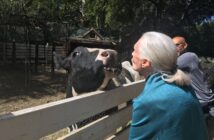In 2012, JGI set the ambitious 30-year goal of protecting with partners chimpanzees in countries that currently cover 85 percent of chimpanzees and their habitats in Africa. One of chimpanzees’ greatest threats is the loss of their habitat. As human populations expand, so too do their need for resources, which in turn threatens forests and woodlands where chimpanzees live. Decision-makers need to monitor these complex, shifting threats to chimpanzee habitats if they are to devise and implement effective conservation plans and evaluate conservation success.
Now, JGI has teamed up with NASA and the University of Maryland to do just that on an unprecedented level of detail and scale: across the entire 2.5 million square kilometer range of chimpanzees in Africa.
With support from NASA’s Applied Sciences Ecological Forecasting Program, JGI and Department of Geographical Sciences at the University of Maryland had just successfully completed the “feasibility stage” and received additional three years of funding to develop an operational Decision Support System (DSS) to monitor chimpanzee habitat health. The DSS integrates Earth observations from 30-meter resolution Landsat satellites with a chimpanzee habitat suitability model and a model forecasting future land use change. The DSS is also enhanced by crowd-sourced field data collected by local communities and protected area rangers using Android smartphones and tablets and Open Data Kit app. The project aims to deploy in the next three years 500 more Nexus tablets contributed in-kind to JGI by Google.
The core research team is led by Dr. Lilian Pintea of JGI (Principal Investigator) along with Dr. Matthew Hansen and Dr. Janet Nackoney (Co-Investigators) and Samuel Jantz, PhD student at the University of Maryland. The DSS will be developed in close collaboration with IUCN SSC Primate Specialist Group, United Nations Environmental Program’s Great Ape Survival Partnership, U.S. Fish and Wildlife Service, Conservation Measures Partnership, Google Earth Outreach, Esri and other partners.
As JGI and partners move forward in developing, testing and validating the DSS pilot in the field and across chimpanzees’ entire range, JGI can use the system to design targeted conservation strategies to support conservation planning using Open Standards. JGI currently supports conservation programs protecting habitat in the four key countries where ODK collection is underway, as well as additional programs in environmental and conservation education in the region. As JGI’s 30-year-plan progresses, JGI can use the DSS not only to plan conservation strategies, but to assess the impact of their conservation actions. This effective oversight ensures that investments are actually working to protect important habitat. Since the DSS maps can model current and desired healthy states of habitat suitability, they will serve as key tools in comparing conservation goals and achievements.
Chimpanzee habitat suitability map for 2005-2010 generated by the project overlaid with chimpanzee sub-species ranges. Source: the Jane Goodall Institute/ University of Maryland.






